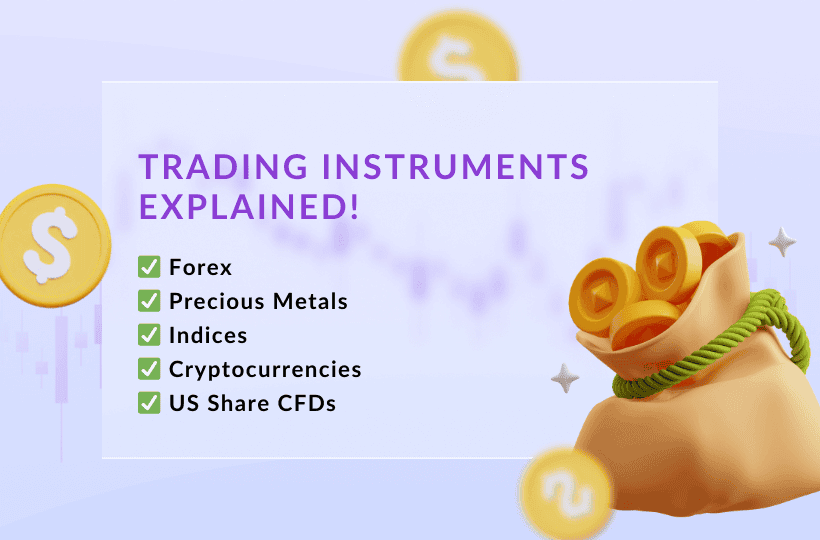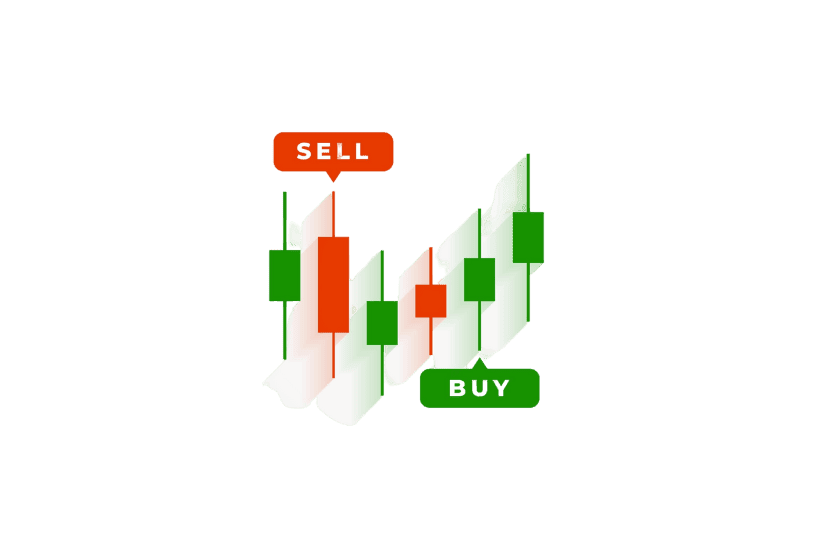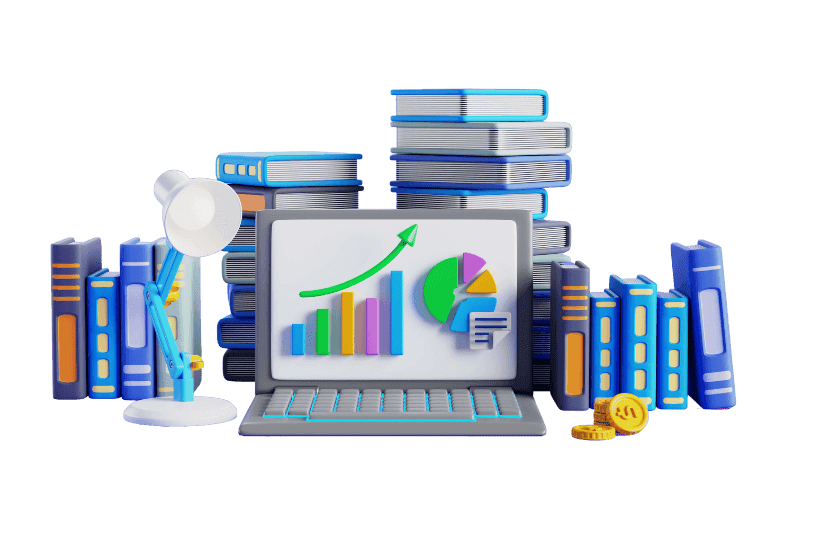Exploring Different Trading Instruments

Read time: 12 minutes.
A diverse range of trading instruments is available in the financial markets, each presenting its own set of opportunities and challenges for investors.
Table of Contents
- Introduction
- Forex Trading
- Precious Metals Trading
- Indices Trading
- Cryptocurrency Trading
- US Share CFDs Trading
- Choosing the Right Trading Instruments
- Conclusion
Introduction
Forex stands out as the largest and most liquid market globally, facilitating currency exchange 24/5 across major financial centres worldwide. Meanwhile, precious metals like gold, silver, and platinum hold enduring appeal as timeless assets valued for their intrinsic worth and utility across various industries.
- Indices, such as the S&P 500, offer snapshots of broader market performance, guiding investors in tracking trends and making informed decisions about resource allocation.
- Cryptocurrencies, such as Bitcoin and Ethereum, have disrupted traditional finance with their decentralised and highly volatile nature, reshaping the financial landscape.
- US share CFDs provide traders with leveraged exposure to American equities without owning the underlying assets, opening up avenues for speculation and hedging within the dynamic US stock market.
Understanding the distinct characteristics and dynamics of each trading instrument is crucial for navigating the financial markets effectively. Each instrument has its own unique features, including liquidity, volatility, and correlations with other assets, which significantly impact trading strategies and risk management approaches.
For example, forex trading thrives on its liquidity and accessibility but is also prone to significant volatility and sensitivity to economic indicators. On the other hand, precious metals often serve as safe-haven assets during times of economic uncertainty but are subject to supply and demand dynamics and geopolitical tensions.
By understanding each asset's characteristics, traders can tailor their strategies to suit specific instruments, maximising opportunities and mitigating risks for consistent and profitable trading outcomes.
![]()
Forex Trading
The foreign exchange market is a global decentralised marketplace where currencies are traded. Participants include banks, financial institutions, corporations, governments, and individual traders.
Currency pairs represent the exchange rate between two currencies. The most commonly traded pairs include EUR/USD (Euro/US Dollar), GBP/USD (British Pound/US Dollar), and USD/JPY (US Dollar/Japanese Yen). Each pair consists of a base currency and a quote currency, with the exchange rate indicating how much of the quote currency is needed to purchase one unit of the base currency.
Forex trading operates 24 hours a day, five days a week, across major financial centres worldwide, including London, New York, Tokyo, and Sydney. This continuous trading cycle allows for around-the-clock trading, providing ample opportunities for market participants to engage in buying and selling currencies.
What moves prices
There are many factors that contribute to the volatile price movements. Economic indicators play a significant role, including interest rates, inflation rates, gross domestic product (GDP) growth, employment figures, and trade balances. Central bank policies, such as monetary policy decisions and interventions in currency markets, can also impact currency valuations.
Geopolitical events and developments, such as political instability, trade tensions, and conflicts, can cause sudden shifts in investor sentiment and currency flows. For example, the current conflicts in Ukraine and Gaza.
Market sentiment, driven by speculation, fear, and greed, can lead to short-term fluctuations in currency prices. Traders often employ a combination of fundamental and technical analysis to anticipate market movements and make informed trading decisions in the dynamic forex market environment.

Precious Metals Trading
Precious metals, including gold, silver, and platinum, have captivated humanity for centuries due to their inherent beauty, scarcity, and utility.
Gold, often referred to as the "king of metals," holds a special place in history as a symbol of wealth, luxury, and stability. Its lustrous appearance and resistance to corrosion make it ideal for jewellery and ornamental purposes.
Silver, known for its affordability and versatility, boasts a wide range of industrial applications, from electronics to medicine.
Platinum, rarer and more precious than gold, is coveted for its durability and resistance to tarnishing, primarily used in catalytic converters, jewellery, and laboratory equipment. Together, these precious metals form the cornerstone of investment portfolios, serving as safe-haven assets and hedges against inflation and economic uncertainty.
What moves prices
The prices of precious metals are influenced by a complex interplay of supply and demand dynamics, along with various economic factors.
On the supply side, mining production, exploration efforts, and recycling rates impact the availability of precious metals in the market. Geopolitical factors, including mining regulations, labour strikes, and geopolitical tensions, can disrupt supply chains and affect production levels.
Demand for precious metals stems from diverse sources, including jewellery fabrication, industrial manufacturing, investment demand, and central bank reserves.
Economic indicators, such as interest rates, inflation expectations, and currency valuations, also exert significant influence on precious metals prices. For instance, during times of economic uncertainty or inflationary pressures, investors flock to precious metals as store-of-value assets, driving prices higher. On the contrary, a strengthening economy or rising interest rates may dampen demand for precious metals, leading to price declines.
Understanding these supply and demand dynamics, coupled with macroeconomic trends, is essential for investors and traders seeking to navigate the intricacies of the precious metals market.

Indices Trading
Stock market indices, such as the S&P 500, play a pivotal role in providing investors with insights into the performance of specific segments of the financial markets. The S&P 500, for example, represents a diverse basket of 500 large-cap US companies, spanning various industries and sectors. These indices serve as benchmarks, allowing investors to gauge the overall health and direction of the stock market. Additionally, they facilitate portfolio diversification and asset allocation strategies by providing a broad overview of market trends and movements.
Stock market indices are calculated using weighted averages of constituent stocks' prices or market capitalisations. The weighting methodology varies depending on the index, with some indices employing market-cap weighting, where larger companies exert a greater influence on the index's performance, while others utilise price weighting or equal weighting.
What moves prices
Changes in the prices of constituent stocks, driven by factors such as corporate earnings, macroeconomic indicators, and investor sentiment, impact the index's value.
Indices are rebalanced periodically to reflect changes in market dynamics, ensuring their relevance and accuracy in tracking overall market performance. By tracking indices, investors can assess the performance of their portfolios relative to the broader market, identify trends, and make informed investment decisions based on market benchmarks.

Cryptocurrency Trading
The cryptocurrency markets exhibit unique features that distinguish them from traditional financial markets, with volatility and decentralisation standing out as prominent characteristics.
Volatility, fuelled by speculative trading, market sentiment, and regulatory developments, is inherent to cryptocurrency markets, leading to rapid price fluctuations and heightened risk.
Additionally, cryptocurrencies operate on decentralised blockchain networks, bypassing traditional financial intermediaries like banks and enabling peer-to-peer transactions. This decentralisation fosters transparency, security, and censorship resistance, empowering individuals to control their assets and participate in a borderless financial ecosystem.
Despite the challenges posed by volatility and regulatory uncertainty, the decentralisation of cryptocurrencies continues to disrupt traditional financial systems, offering a glimpse into the future of finance.

US Share CFDs Trading
US Share CFDs trading offers investors a flexible and leveraged approach to accessing US equity markets without owning the underlying assets.
Contracts for Difference (CFDs) allow traders to speculate on the price movements of US shares, including popular companies such as Apple, Google, and Amazon, without the need for direct ownership.
CFDs provide flexibility, enabling traders to take both long and short positions on US shares, thereby capitalising on both rising and falling markets. However, it's essential to acknowledge the risks associated with CFD trading, such as leverage-induced losses, counterparty risk, and overnight financing charges.
In addition to maintaining strict risk management, traders need to stay informed about market developments, and conduct thorough research, in order to mitigating risk and achieving long-term success in trading US share CFDs.
Click here for more information on the trading products provided by Fusion Markets.

Choosing the Right Trading Instruments
Selecting the right trading instruments is a critical decision that hinges on various factors, including individual trading goals, experience level, and risk tolerance.
Novice traders may opt for instruments like forex or precious metals, known for their liquidity and relatively lower entry barriers.
Experienced traders, on the other hand, might explore more complex instruments such as cryptocurrencies or US share CFDs, leveraging their market knowledge and risk management skills.
It's essential to align chosen instruments with specific trading objectives, whether it be short-term speculation or long-term investment. Additionally, understanding one's risk tolerance is essential, as certain instruments, like cryptocurrencies, are inherently more volatile than others and may not suit everyone's risk appetite.
Diversification and portfolio management also play a crucial role in mitigating risk and optimising returns when trading multiple instruments. Diversifying across different asset classes, such as stocks, bonds, commodities, and currencies, helps spread risk and minimise exposure to any single market or sector.
Additionally, within each asset class, diversification can be achieved by selecting a mix of instruments with varying risk profiles and correlations. Effective portfolio management involves regularly reviewing and rebalancing the portfolio to ensure alignment with changing market conditions and investment objectives. By diversifying and actively managing their portfolios, traders can enhance resilience against market fluctuations and achieve more consistent and stable returns over the long term.
Conclusion
Navigating the diverse array of trading instruments demands a comprehensive understanding of their respective characteristics and dynamics. From the liquidity of forex markets to the resilience of precious metals, each instrument presents unique opportunities and challenges for traders.
By embracing sound risk management principles, honing analytical skills, and aligning trading strategies with individual objectives, market participants can prosper in any market environment.
As you dive deeper into the world of trading, we encourage you to explore our range of products and accounts at Fusion Markets, empowering you to seize opportunities and chart your path to financial success.
We’ll never share your email with third-parties. Opt-out anytime.